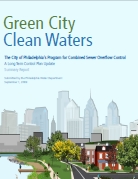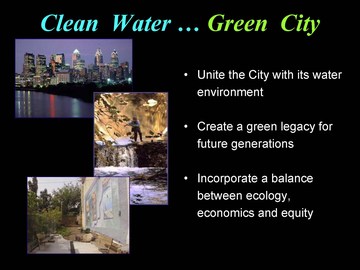Philadelphia's ambitious plan to keep sewage out of drinking water relies on trees, not tunnels
Plan Envisions Absorbent Landscape
“The traditional way to handle stormwater is to steer it as quickly as possible down sewers and into waterways, building expensive underground tunnels and tanks to handle the overflows. In Philadelphia, estimates for the cost of that project run to $7.5 billion,” writes Dana DiFilippo in an online article published by OnEarth, an environmental magazine.
Peel Back the Hard Surfaces
“So instead, the city has embraced a very new idea: Don't collect the stormwater at all. Instead, let it fall on an environmentalist's paradise of 300,000 newly planted trees, urban farms and rain gardens, new wetlands, rain barrels, green roofs, and porous pavement.”
“Experts say it's the most ambitious and environmentally friendly stormwater management plan in the country and could serve as a model for cities nationwide.”
Design with Nature
“For the past 150 years, we have been putting down concrete barriers to nature and  ‘protecting' our population from the environment,” says Howard Neukrug, director of the Philadelphia Water Department's Office of Watersheds. “This plan is about partnering with the environment to create a better quality of life.”
‘protecting' our population from the environment,” says Howard Neukrug, director of the Philadelphia Water Department's Office of Watersheds. “This plan is about partnering with the environment to create a better quality of life.”
To read the complete article by Dana DiFilippo, click on Philly Seeks Answers Down the Drain.
To Learn More About Philladelphia's Bold Plan
To access stories previously published on Water Bucket, click on these links:
- Clean Water….Green City: Blending the interests of land and water in Philadelphia.
- Philadelphia's bold plan for rainwater/stormwater management envisions “giant sponge”

Acknowledgments:
Dana DiFilippo is a veteran newspaper and magazine reporter. She currently works at the Philadelphia Daily News and has written for the Cincinnati Enquirer, the Bucks County Courier Times, the North Hills (Pa.) News Record, American Baby magazine, and other publications.
Founded in 1979 as The Amicus Journal, OnEarth is published by the Natural Resources Defense Council (NRDC) in the United States, and continues NRDC's 25-year commitment to independent, groundbreaking environmental journalism
Posted February 2010

